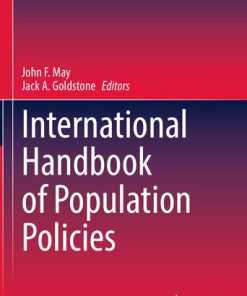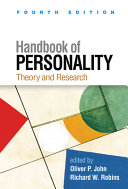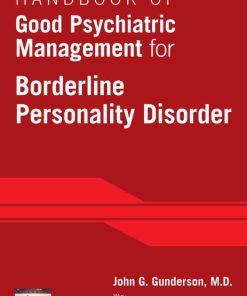The Handbook of Personality Dynamics and Processes 1st Edition by John F Rauthmann ISBN 9780128139950 0128139951
$50.00 Original price was: $50.00.$25.00Current price is: $25.00.
The Handbook of Personality Dynamics and Processes 1st Edition by John F Rauthmann – Ebook PDF Instant Download/Delivery: 9780128139950 ,0128139951
Full download The Handbook of Personality Dynamics and Processes 1st Edition after payment

Product details:
ISBN 10: 0128139951
ISBN 13: 9780128139950
Author: John F Rauthmann
The Handbook of Personality Dynamics and Processes is a primer to the basic and most important concepts, theories, methods, empirical findings, and applications of personality dynamics and processes. This book details how personality psychology has evolved from descriptive research to a more explanatory and dynamic science of personality, thus bridging structure- and process-based approaches, and it also reflects personality psychology’s interest in the dynamic organization and interplay of thoughts, feelings, desires, and actions within persons who are always embedded into social, cultural and historic contexts.
The Handbook of Personality Dynamics and Processes tackles each topic with a range of methods geared towards assessing and analyzing their dynamic nature, such as ecological momentary sampling of personality manifestations in real-life; dynamic modeling of time-series or longitudinal personality data; network modeling and simulation; and systems-theoretical models of dynamic processes.
Ties topics and methods together for a more dynamic understanding of personality
Summarizes existing knowledge and insights of personality dynamics and processes
Covers a broad compilation of cutting-edge insights
Addresses the biophysiological and social mechanisms underlying the expression and effects of personality
Examines within-person consistency and variability
The Handbook of Personality Dynamics and Processes 1st Edition Table of contents:
Section I: Concepts and domains
Chapter 1. The history of dynamic approaches to personality
Abstract
Introduction
Early dynamic models
Control theory: The power of feedback
Formal models of personality dynamics
Dynamic processes ≠ stochastic variation
Some classic diary studies
Data collection methods
The ESM revolution
Conclusions
References
Chapter 2. Personality processes—From description to explanation
Abstract
Personality processes—From description to explanation
Where we stand (or: the customary way of thinking in personality psychology)
Why we doubt (or: the obstacle that hinders us to stay on the customary path)
Which arguments might justify traits as explanation (or: the—fruitless—attempt to remain on the customary path)
Why a new focus on personality processes is worth it (or: the exciting new path)
Who should search for processes (or: our point of departure)
What the actual state of knowledge concerning psychological processes is (or: how far we have gone on the new path)
How processes can be grouped and compared (or: a signpost for a unified work on processes)
How considering psychological processes connects subdisciplines (or: the bridges that are included in this path)
What shall be done with the trait concept (or: back to the roots)?
References
Chapter 3. Psychological processes and mechanisms to explain associations between personality traits and outcomes
Abstract
Acknowledgments
Overview of traits and trait mechanisms
Mediating mechanisms
Moderating mechanisms
Processes involving both moderation and mediation
Final remarks
References
Chapter 4. Within-person variability
Abstract
Early conceptualizations
Moving toward a science of within-person variability
Future directions
Conclusion
References
Chapter 5. Processes of personality development: An update of the TESSERA framework
Abstract
Acknowledgments
Introduction
Repeated momentary processes of situations, experiences, behaviors, and reactions
Associative and reflective processes during personality development
Conclusion
References
Chapter 6. Personality dynamics in the brain: Individual differences in updating of representations and their phylogenetic roots
Abstract
Acknowledgments
Introduction
Basic personality traits that reflect individual differences in PARCS
Dynamics of PARCS
Conclusion
References
Chapter 7. Synergistic and dynamic genotype-environment interplays in the development of personality differences
Abstract
Acknowledgments
Introduction
Theoretical considerations of genetic differences: Genes, apes, and bananas
Quantifying relative genetic and environmental contributions
Relative genetic and environmental contributions to personality differences
Unfolding of genetic and environmental influences in personality differences
Interplay of genetic and environmental influences on personality differences
Cutting-edge research on genotype-environment interplays in personality development
Conclusions and an integrative perspective
References
Chapter 8. Social interaction processes and personality
Abstract
Situating social interaction processes: Structure and content of a complex process domain of personality
The PERSOC framework: Understanding social interaction process chains and their relation to personality expression, consequences, and development
Interaction state contingencies and fluctuations
Empirical findings regarding individual differences in social interaction states
Limitations, perspectives, and implications: Understanding and assessing personality traits as dynamic social interaction systems
Conclusions
References
Chapter 9. Wild horses dressed like unicorns: Relationship effects on personality
Abstract
Levels of analysis
Relationship effects in ego-centered networks
Relationship effects in partner relationships
Methodological considerations
Outlook and future directions
Conclusion
References
Chapter 10. Culture and personality processes: Basic tenets and current directions
Abstract
Culture: Its nature and many forms
Culture and personality studies: Back to the future
Basic debates never die: Emic vs. etic approaches
New theoretical developments
Personality and multiculturalism
Conclusion
References
Chapter 11. Psychopathology and personality functioning
Abstract
Medicalization of personality disorder diagnosis
Shift toward empirical classification
Extremity is not necessary or sufficient to define dysfunction
Maladaptive trait models
Mechanistic trait models
Integrating mechanistic models with existing clinical theory
The challenge of defining dysfunction
A comprehensive model of dysfunction
Summary
References
Chapter 12. Motives and goals, or: The joys and meanings of life
Abstract
Acknowledgment
Modes of behavior regulation
Motives
Goals
Relationships and interactions between motives and goals
Achieving motive-goal congruence
Coda: The contributions of motives and goals to well-being
References
Chapter 13. Fates beyond traits: The dynamics and impacts of personal project pursuit
Abstract
Units of analysis in personality psychology: Challenge and change
PPA: A multimodular methodology
The social ecology of personal project pursuit
Acting out of character: The dynamics of free traits
Well-doing: Core projects and their sustainable pursuit
References
Chapter 14. Self-regulatory processes and personality
Abstract
Personality traits as predicting self-regulation
Self-regulation as predicting personality traits
Stable individual differences in self-regulation
Conclusion
References
Chapter 15. Dynamic self-processes
Abstract
Introduction
Toward a classification of self-processes
Self-awareness
Mental time travel
Self-knowledge
Other important self-processes
Conclusion
References
Chapter 16. Narrative, identity, and the life story: Structural and process approaches
Abstract
Two theoretical “stories” about stories
Bringing the two frameworks together
Conclusions and directions for future work
References
Chapter 17. Integrative processes and personality coherence across levels of functioning
Abstract
The coherent actor
The coherent agent
The coherent author
Reflection and conclusion
References
Section II: Perspectives and theories
Chapter 18. Capturing interactions, correlations, fits, and transactions: A Person-Environment Relations Model
Abstract
Introduction
Respecifying the Lewinian formula
A general Person-Environment Relations Model (PERM)
Person-environment relations
Person-environment calibrations and navigation mechanisms
Recommendations and future directions
Conclusion
References
Further reading
Chapter 19. Evolutionary perspectives on the mechanistic underpinnings of personality
Abstract
Acknowledgment
Overview
Evolution and phenotypic variation
Evolutionary personality science
Concluding remarks
References
Chapter 20. Dual process models of personality
Abstract
Dual process approaches to the personality self-concept
Dual process approaches to motive dispositions
Empirical evidence on the reliability and validity of indirect personality measures
Advanced issues
Controversial issues
Conclusions
References
Chapter 21. Whole Trait Theory puts dynamics at the core of structure
Abstract
The big five and HEXACO are real and in need of explanation
Whole Trait Theory
The whole trait: Explanatory and descriptive parts
Empirical evidence for WTT claims
Future research directions
Conclusion
References
Chapter 22. The KAPA model of personality structure and dynamics
Abstract
The KAPA model: Conceptual premises
The KAPA model: Theory of personality architecture
The KAPA model: Theory of personality assessment
The KAPA model: Empirical strategies for identifying cross-situational coherence
Limitations and future directions
References
Chapter 23. Lifespan trait development: Toward an adequate theory of personality
Abstract
Acknowledgments
The evolution of FFT
A new test of social investment
FFT as a guide to studying trait developmental processes
Future directions
References
Chapter 24. Using functional fields to represent accounts of the psychological processes that produce actions
Abstract
Formally representing the psychological processes that produce actions
Using functional fields to represent the situation as perceived by the actor
Representing the field from verbal statements
Traits as regularities in forces within the person’s field
Worked example: Why did Frank Abagnale start a life of crime? (and then, why did he stop?)
Broader applications of functional fields
Creating field models to simulate possible interventions
Conclusion
References
Chapter 25. Interpersonal theory and personality processes
Abstract
Introduction
Interpersonal processing and dysfunction
Contrasting EMA and CAID methods
Future directions
Conclusion
References
Chapter 26. Dynamic pathways of personality: A further development of the personality systems framework
Abstract
Dynamics in a structural context
Dynamics are shaped by structure
Dynamics of self-control
Dynamics of action
Discussion
Conclusion
References
Chapter 27. Personality systems interactions (PSI theory): Toward a dynamic integration of personality theories
Abstract
Seven levels of personality functioning: Integrating divergent theories of personality
Systems interactions underlying decisiveness and self-growth
Conclusions
References
Section III: Methods and statistics
Chapter 28. Variability and consistency in the analysis of behavior
Abstract
Traditional conceptual and analytic approaches
The simplest case: Persons and situations
The slightly more complex case: Persons, situations, and person-situation interaction
A more than “slightly more” complex case: Persons, situations, and observations
Alternative estimation procedures
Summary
References
Chapter 29. Mobile sensing for studying personality dynamics in daily life
Abstract
Mobile sensing for capturing personality expression in daily life
Guidelines for studying personality dynamics using mobile sensing
Design factors to consider before launching a mobile sensing study
Description of tutorial materials
Analytic techniques to consider when working with sensor data
Describing within-person variability
Examining patterns over time
Identifying within-person dimensions
Conclusion
References
Chapter 30. Experience sampling and daily diary studies: Basic concepts, designs, and challenges
Abstract
Background of ESM studies
Research questions for experience sampling studies
Designing an experience sampling study
Preregistration of experience sampling studies
Platforms for experience sampling studies
Summary
References
Chapter 31. Modeling developmental processes
Abstract
Individual, mean, and differential change
Mean level, positional and rank-order stability, and linear change
Methods for describing developmental trajectories
Models for explaining developmental trajectories
Conclusion
References
Chapter 32. What if apples become oranges? A primer on measurement invariance in repeated measures research
Abstract
Acknowledgments
Introduction
What is measurement invariance?
A method for testing invariance
Advanced techniques for testing invariance
The practical impact of noninvariance
When invariance fails
The future of invariance testing
Conclusion
References
Chapter 33. Multilevel structural equation modeling for intensive longitudinal data: A practical guide for personality researchers
Abstract
Acknowledgments
Multilevel structural equation modeling for intensive longitudinal data: A practical guide for applied personality researchers
Issues associated with ILD in personality research
A basic introduction to MSEM
Empirical demonstrations
Discussion
Conclusion
References
Chapter 34. Hierarchical continuous time modeling
Abstract
Overview
Additional details
Conclusion
References
Chapter 35. Multitrait-multimethod-multioccasion modeling of personality data
Abstract
Acknowledgments
Multitrait-multimethod-multioccasion modeling of personality data
Data example
Results
Conclusion
References
Chapter 36. Dyadic data analysis
Abstract
Acknowledgment
Dyadic data analysis
Analysis of dyadic data from single dyads
Cross-sectional dyadic data
Analyzing dyadic data from dyads in groups
Conclusion
References
Chapter 37. Longitudinal structural equation modeling of personality data
Abstract
Acknowledgments
Models for examining state variability
Models for measuring change
Conclusion
References
Chapter 38. Finding order in the flow of personality: Dynamical systems techniques for measuring personality coherence and change
Abstract
Dynamics in personality theory and research
Key concepts in dynamical systems theory
Applying dynamical systems methods to study personality
Conclusion
References
Chapter 39. Personality traits in social interactions: A tutorial on network analysis of personality dynamics
Abstract
Introduction to network analysis
A tutorial on network analysis of personality dynamics
Implications for personality dynamics
General conclusions
References
Chapter 40. Virtual personalities and neural networks: Capturing the structure and dynamics of personality
Abstract
Goals of the current approach
Theoretical background
Overview of neural networks
Advantages of building a neural network model
Simulations
Conclusion
References
Section IV: Applications
Chapter 41. Personality dynamics in the workplace: An overview of emerging literatures and future research needs
Abstract
Personality defined
Representative literatures bearing on personality dynamics at work
Offerings of personality dynamics to work psychology
A partial model of personality dynamics in the workplace
Future research needs
Conclusion
References
Chapter 42. Within-person variability in job performance
Abstract
Acknowledgments
Job performance and within-person variability therein
Why is it important to adopt a within-person perspective on job performance?
Theories relevant to within-person job performance variability
Elaborating upon individual theories and integrating across theories: A road map
Implications for practice in organizational settings
References
Chapter 43. Process perspectives on leader traits, behaviors, and leadership situations
Abstract
A short summary of leader-trait research
Leaders and leadership outcomes: Which traits do matter?
A look into the leadership process: How and when do leader traits work?
Conclusion and outlook
References
Chapter 44. Assessing personality dynamics in personnel selection
Abstract
Acknowledgments
Traditional personality assessment in personnel selection
Toward a dynamic approach to personality in selection
Personality dynamics—A review of relevant concepts
Assessing personality dynamics using personality inventories
Assessing personality dynamics using situational judgment tests
Assessing personality dynamics using assessment center exercises
Quantification of within-person variability
Conclusion
References
Chapter 45. An integrative framework to study wisdom
Abstract
Acknowledgments
The many faces of wisdom
Integrating wisdom literatures
A process-oriented framework to study wisdom
The nomological lens model network
Exemplary application of the NLMN to two selected wisdom models
The NLMN as an integrative framework of wisdom
Conclusion
References
Chapter 46. Dynamic processes underlying individual differences in moral behavior
Abstract
Acknowledgments
Dynamic processes constituting individual differences in moral behavior
Individual differences proposed specifically to explain or describe moral behavior
A six-category taxonomy of individual differences in moral character
Category 1: Perception of moral relevance
Category 2: Judgment of morally correct behavior
Category 3: Affective prompts and inhibitors
Category 4: Identification with morality or others
Category 5: Moral courage and follow-through
Category 6: Enacted morality
Dynamic processes underlying these individual differences
Conclusion
References
Chapter 47. Personality and stress
Abstract
Acknowledgment
Personality and stress
Personality and stress: Concepts and definitions
Part I. Personality and stress: Short-term dynamics
Part II. Personality and stress: Long-term change
General remarks
References
Chapter 48. Subjective well-being as a dynamic construct
Abstract
Acknowledgments
Subjective well-being as a dynamic construct
How dynamic is SWB?
Short-term dynamics of SWB
Long-term dynamics of SWB
Conclusion
References
Chapter 49. Health processes in personality
Abstract
Health processes in personality
Personality traits and health outcomes
Mechanisms explaining personality-health associations
Personality and health processes model
Personality within medical settings
Conclusions
References
Chapter 50. Dynamics and processes in personality change interventions
Abstract
Dynamics and processes in personality change interventions
What are personality traits?
Can personality traits change?
Interventions to change personality traits
Volitional personality change interventions
Future directions
Conclusion
References
Chapter 51. PSI theory in action: The assessment of self-competences as an aid in counseling and therapy
Abstract
A short intro into PSI theory
Client A—When the self is not accessible
Client B—When the self is too accessible
People also search for The Handbook of Personality Dynamics and Processes 1st Edition:
the handbook of personality dynamics and processes pdf
dynamics and processes in personality change interventions
what is dynamics of personality
personality dynamics definition
personal dynamics meaning
You may also like…
History & Research
Handbook of Personality Disorders Second Edition Theory Research and Treatment W. John Livesley
History & Research
Politics & Philosophy - Social Sciences
International Handbook Of Population Policies 1st Edition John F. May
Physics - Others
Psychology - Social Psychology
Handbook of Personality Theory and Research 4th Edition Oliver P. John
Uncategorized
John F Kennedy and the Liberal Persuasion 1st Edition by John M Murphy ISBN 9781609175832 1609175832
Psychology - Psychological Disorders
The Cambridge Handbook of Personality Disorders 1st Edition Carl W. Lejuez











